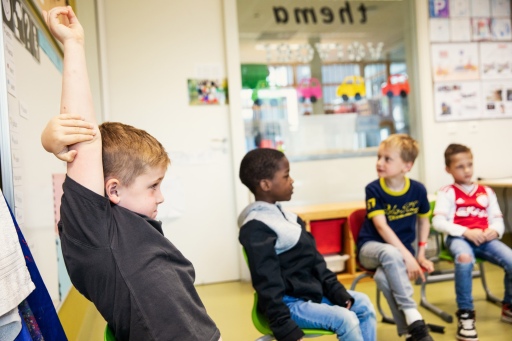Preventive and mild curative interventions
In addition to providing education in the classroom, each school also has a range of measures it can take when students need (light) support. For the most part, these protocols and interventions fall under the provision of good education in our partnership. These include knowledge of the learning lines 1F and 1S, knowing how to deal with bullying or suspected dyslexia and providing a positive pedagogical learning environment.
Below is a summary of the agreed upon preventive and mild curative interventions. Based on our experience, this component of basic support seems to vary the most between schools. The school’s School Support Profile (SOP) describes what the school can offer in terms of education, preventive and light curative interventions, extra support and youth assistance.

A positive pedagogical climate
In all schools, teachers work to create a shared (positive pedagogical) climate. School and group rules have been established. Teachers and students are familiar with these rules and these rules are enforced. If necessary, the school may provide additional guidance for students to adhere to school and group rules. At all schools, teachers have interventions in place to address single (mild) behavioral support needs.
Identifying students with their own learning line and setting up a plan of action
Schools are able to identify students who need an adapted learning line within a group if they do not reach the 1F level or deviate significantly from the offer of the rest of the group. A school is able to make a plan of action for this and make the necessary adjustments.
Identify students in need of a challenging, in-depth learning environment beyond the current curriculum and set up a plan of action
In all schools, teachers can deploy aligned offerings for these students:
– The school has a protocol for recognizing students who are more- or more gifted.
– The school has assignments to challenge students creatively and critically.
– The school has a rich learning environment (additional materials, resources, research opportunities and ICT).
Differentiate between students
In all schools, teachers are able to use various tools/ICT to differentiate between students. Consider offerings in the area of level work or a motor support need. Ensuring that the school building is physically accessible to all students is also part of this.
Identifying and supporting students with learning support needs
In all schools, teachers identify students who need support with executive functions. Teachers have various interventions available to promote learning to learn, such as teaching flexibility, time management and planning.
Identifying, differentiating and supporting students with support needs for appropriate reading instruction
All schools use the protocols as developed by the Dyslexia Support Center. Special (elementary) education schools work with a description of their approach to reading problems and dyslexia appropriate to their own school population.
Identify, differentiate and support students with support needs for appropriate math and math instruction
All schools use the Dyscalculia Protocol, as developed nationally. Special (primary) education schools work with a description of their approach to arithmetic problems and dyscalculia appropriate to their own school population
Protocols
Each school works with at least the following protocols:
– Bullying protocol
– Child abuse report code
– Social safety plan
– Risk inventories
– Medical treatment protocol
– Death/fidelity protocol
To the extent that protocols are available at the national level (at least child abuse report code and risk inventories), these national protocols are used.
Absence and stay-at-home
All schools work in accordance with the Hague approach with regard to absenteeism, suspension and removal and the SPPOH-wide agreements with regard to reporting possible stay-at-home, interim transfers and difficult applications.
Parent Involvement
A booklet full of inspiring stories about increasing parent involvement in schools and districts where it is challenging. Examples of practical situations from schools in Haaglanden, where big results have been achieved with small changes. And where a different way of communicating really made a difference.
Read it here
A publication of Gemeente Den Haag, SPPOH, Ons Verbind, Stichting Jeugdwerk & Project Buitenkans
